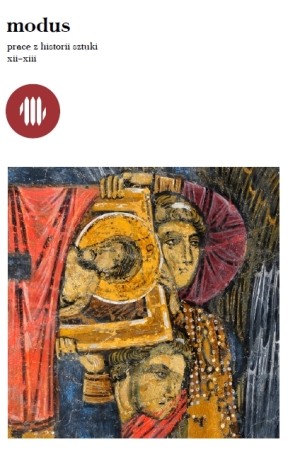Bizantyńskie malowidła w prezbiterium katedry pw. Narodzenia Najświętszej Maryi Panny w Sandomierzu - odkrycia niespodziewane i doniosłe
The Byzantine Mural Paintings in the Chancel of the Cathedral of the Birth of the Virgin at Sandomierz - Unexpected and Momentous Discoveries
Author(s): Małgorzata Smorąg-RóżyckaSubject(s): Fine Arts / Performing Arts, Architecture, Visual Arts, History of Art
Published by: Wydawnictwo Uniwersytetu Jagiellońskiego
Keywords: bizantine mode;opere graeco;painting;bizantine paintings;Wiślica;Sandomierz;Byzantine;Byzantine aesthetics;
Summary/Abstract: The investigation of the Byzantine mural paintings commissioned by the members of the Jagiellonian dynasty closely followed the uncovering of murals from under layers of early modern plastering, first at Sandomierz Cathedral (1887,1913-1914, 1932-1934), then at the Castle Chapel in Lublin (1899-1922) and finally in the collegiate church at Wiślica (1915, 1919-1920). After Second World War the examinations were continued in Lublin (1954-1959 and 1973-1997, in several stages), at Wiślica (1950S and 1960S) and at the Holy Cross Chapel in the cathedral on Wawel Hill (1949-1951). A new phase of research was opened by the comprehensive investigations and preservation measures applied first at Wiślica (1995-2000) and then at the chapels in Cracow Cathedral on Wawel Hill, namely the Holy Cross Chapel (1997-2001) and the Bathory Chapel of the Nativity of the Virgin (2004-2006), where a spectacular discovery took place of substantial fragments of paintings representing distinguishable scenes depicting the Annunciation, Washing the Feet of the Apostles, Harrowing of Heli and some ornamental motifs. In 2008-2011 a comprehensive conservation treatment, encompassing also the Byzantine mural paintings, was carried out in the chancel of Sandomierz Cathedral. In the course of the works some hitherto unknown fragments were uncovered. The discoveries included the following:1. previously unknown compositions on the yaulting (Christ Pantocrator, fragments of a Liturgical Procession of Angels), on the south wali (Annunciation, Harrowing of Hell, figures of two saint deacons), on the north wali of the first bay from the west (a row of nine coats-of-arms);2. newly uncovered fragments of previously known compositions on the apse wali (Nativity of Christ, Nativity of the Virgin, Crucifixion)3. original paint layer of almost entire painting surface with perfectly preserved colours, gilding (in a few fragments) and chiaroscuro modelling; 4. (fragmentary and illegible) inscriptions in Cyrillic within a few compositions, depictions of prophets and saint virgins as well as fragments of foundation inscriptions (?) on the south and north walls of the chancel arch. While interpreting the iconographic programme of the Sandomierz paintings, special attention should be paid to the frieze of nine coats-of-arms on the north wali, which forms an integral part of the entire concept. The coat-of-arms of Annę of Cilly, second wife of king Jagiełło, located in heraldic hierarchy on the east edge of the frieze, may serve as an important clue for the dating of the Sandomierz paintings to the period between 1402/1403 (the marriage took place on 29 January 1402; Anna was crowned on 23 February 1403) and 1416 (Annas death, on 21 March), with a datę of 8 April 1408 being of particular importance since it was then that Jadwiga, the daughter of the couple, recognised as the heiress to the throne at the rally at Jedlnia in 1413, was born.
Journal: Modus. Prace z historii sztuki
- Issue Year: 2013
- Issue No: 12-13
- Page Range: 53-72
- Page Count: 19
- Language: Polish

